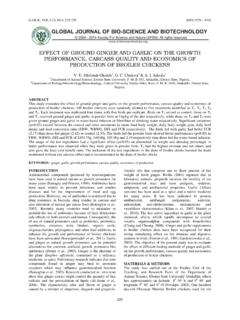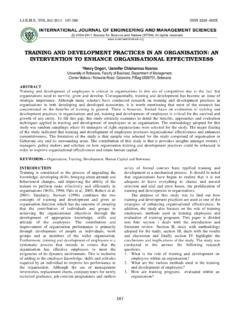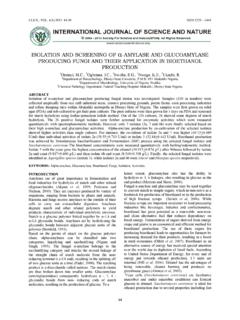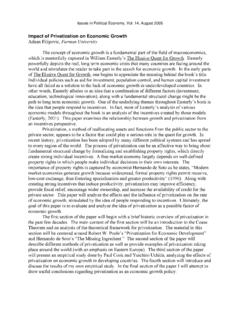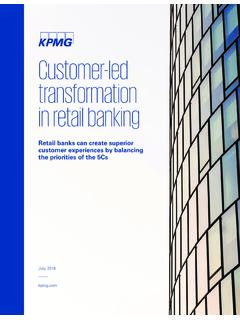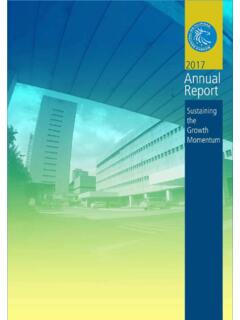Transcription of FUNDAMENTAL ANALYSIS vs. TECHNICAL ANALYSIS: A …
1 , (2) 2013:234-246 ISSN 2229-600X234 FUNDAMENTAL ANALYSIS vs. TECHNICAL ANALYSIS : A CHOICE OFSECTORAL ANALYSIS1 Keerti Gururaj Kulkarni,2 Gururaj Anand Kulkarni1 Gogte Institute ofTechnology, , paper explores the analytical tools in evaluating sectoral stocks. In particular focus has been set to understand thegenesis of FUNDAMENTAL and TECHNICAL ANALYSIS in evaluating the sectoral ascertain this effectively, fundamentaland TECHNICAL ANALYSIS have been carried out among stocks of selected sectors. Further, an effort has been made to develop stock selection criteria for stocks of these sectors. Also, the strategies used by theinvestors in evaluating these sectoralstocks have been : FUNDAMENTAL ANALYSIS , TECHNICAL ANALYSIS , Stocks, is one of the fastest growing economies of the world,with an average GDP growth rate of around over thelast few years.
2 It has emerged as the world'sfastestgrowing wealth creator, thanks to its buoyant stock marketand higher name stock market whencomes into the mind, everyone has different opinion. Onefeels it is risky to invest in stock market, others mayperceive that it is game of gambling. Many of the investorsmay feel its great opportunity to make profits in the stockmarket. The opinion differs from person to person andinvestor to investor. However, looking into the recenttrends in the stock market of its volatility, if the investoraskshimself about why the stock market behaved thisway; the answer is, the factors may be many.
3 One has todevelop a bird s view over the stock market, and analyzeevery factor with tools and techniques so that he/she maynot go wrong in the investment of the tools may be TECHNICAL ANALYSIS which helps tostudy the market action, primarily through the use ofcharts, for the purpose of forecasting future price movement of the scrip price and its behavior can beexplained in a more illustrative form by using the technicalanalysis. It provides better insight to make decisions onthe stock investments. It considers only the actual pricebehavior of the market or paper presents a brief introduction to the stockmarket, FUNDAMENTAL versus TECHNICAL ANALYSIS for theselection of the stocks for better mainobjective behind the project is to understand theinvestment decisions, when comparing fundamentalanalysis with that of the TECHNICAL ANALYSIS .
4 Further, thecore area of this work focuses on TECHNICAL andfundamental ANALYSIS of 5 sectors, their choices/selectioncriteria, which tells an investor when to buy or sell a work has made use of the secondary data forcalculating the returns, and hence making decisions oninvestments in the stocks. This paper is byproduct of themajor concurrent project carried out in GUPTAEQUITIES PVT LTD , Hubli branch. Respondents ofHubli and Dharwad cities of Karnataka state, India are thesample units of investmentfor the primary OF STOCK MARKET IN INDIAThe origin of the stock market in India goes back to theend of the eighteenth century when long-term negotiablesecurities were first issued.
5 However, for all practicalpurposes, the real beginning occurred in the middle of thenineteenth century after the enactment of the CompaniesAct in 1850, which introduced the features of limitedliability and generated investor interest in important early event in the development of the stockmarket in India was the formation of the nativeshare andstock brokers' Association at Bombay in 1875, theprecursor of the present day Bombay Stock was followed by the formation ofassociations/exchanges in Ahmedabad (1894), Calcutta(1908), and Madras (1937). In addition, a large number ofephemeral exchanges emerged mainly in the buoyantperiods to recede into the oblivion during depressing exchanges are intricacy inter-woven in the fabric ofa nation's economic life.
6 Without a stock exchange, thesavings ofthe community, the sinews of the economicprogress and productive efficiency would remainunderutilized. The task of mobilization and allocation ofsavings could be attempted in the olden days by a muchless specialized institution than the stock exchanges. Butas the business and industry expanded, and the economyassumed more complex nature, the need for 'permanentfinance' arose. Entrepreneurs needed money for long termwhereas investors demanded liquidity the facility toconvert their investment intocash at any given time. Theanswer was a ready market for investments, and this washow the stock exchange came into exchange means anybody of individuals, whetherincorporated or not, constituted for the purpose ofregulating or controllingthe business of buying, selling ordealing in securities.
7 These securities include; FUNDAMENTAL ANALYSIS vs. TECHNICAL Analysis235(i)Shares, bonds, debentures or other marketablesecurities of alike nature in or of any incorporatedcompany, or other body corporate(ii)Government securities(iii)Rights orinterest in securitiesThe Bombay Stock Exchange (BSE) and the NationalStock Exchange (NSE) of India are the two primaryexchanges in India. In addition, there are 22 RegionalStock Exchanges. However, the BSE and NSE haveestablished themselves as the two leading exchanges andaccount for about 80 per cent of the equity volume tradedin India.
8 The NSE and BSE are equal in size, in terms ofdaily traded volume. The average daily turnover at theexchanges has increased from Rs 851 crores in 1997-98 toRs 1,284 crores in 1998-99, and further to Rs 2,273 croresin 1999-2000 (April-August 1999). NSE has around 1500shares listed with a total market capitalization of aroundRs 9, 21,500 BSE has over 6000 stocks listed and has a marketcapitalization of around Rs 9, 68,000 crore. Most keystocks are traded on both the exchanges and hence theinvestor could buy them on either exchange. Bothexchanges have different settlement cycles, which allowinvestors to shift their positions on the bourses.
9 Theprimary index of BSE is BSE Sensex comprising of 30stocks. NSE has the S&P NSE 50 Index (Nifty) whichconsists of fifty stocks. The BSE Sensex is the older andmore widely followed index. Both these indices arecalculated on the basis of market capitalization andcontain the heavily traded shares from key are closed onSaturdays and theexchanges have switched over from the open outcrytrading system to a fully automated computerized mode oftrading known as BOLT (BSE OnLine Trading) andNEAT (National Exchange Automated Trading) System. Itfacilitates more efficient processing, automatic ordermatching, faster execution of trades and transparency; thescrips traded on the BSE have been classified into 'A', 'B1','B2', 'C', 'F' and 'Z' groups.
10 The 'A' group shares representthose, which are in the carry forward system(Badla). The'F' group represents the debt market (fixed incomesecurities) segment. The 'Z' group scrips are theblacklisted companies. The 'C' group covers the odd lotsecurities in 'A', 'B1' & 'B2' groups and Rightsrenunciations. The key regulator governing StockExchanges, Brokers, Depositories, Depositoryparticipants, Mutual Funds, FIIs and other participants inIndian secondary and primary market is the Securities andExchange Board of India (SEBI).FINANCIAL MARKETThe financial market includes Money market and Capitalmarket.
